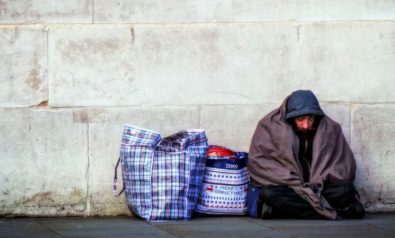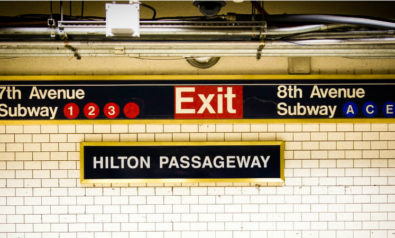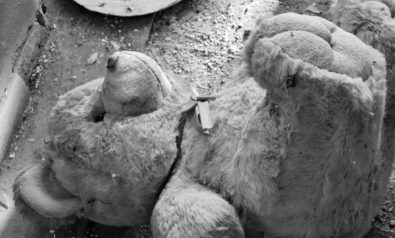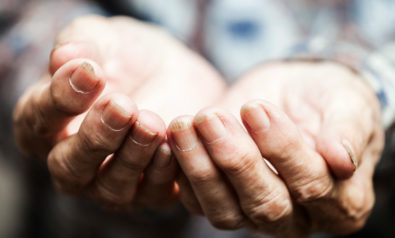In Oakland, roughly 3,000 men, women, and children have nowhere to sleep.
On the hottest day of the year, the shelter appeared against the back wall of an abandoned brick building. Oakland has a way of manifesting piles of garbage and the detritus from apartments emptied by eviction on the sidewalks overnight; the tiny structure went unmarked for several days before anyone noticed the change to the shape of the mostly abandoned industrial neighborhood.
When notice came, it was not positive attention.
The social network Nextdoor is meant to function like Facebook for one’s specific neighborhood. Oakland changes block to block; this particular part is referred to by Oakland police as Dogtown. The Dogtown page lit up one morning with a hotly contested thread:
User 1: Does anyone know who put that mobile homeless shelter on the corner of B___ and A___?
User 2: There’s an artist named Gregory Kloehn who creates them. There was a story about him in the paper.
User 1: I just want his name so I can report him for illegal dumping.
What followed was a frenzy of finger-pointing: accusations on all sides of not caring for the homeless populations, or caring but not wanting homeless citizens of Oakland in one’s own neighborhood. No resolution came out of it. The shelter is still there.
Dogtown’s first little shelter was not made by Gregory Kloehn. It doesn’t bear his stamp of whimsical colors or irregular shapes. Its occupant is a tall black man who comes out every morning and sweeps his little section of the street. Around his home he is slowly amassing a phalanx of shopping carts and castoff furniture — since that hot day it’s grown too large to be missed, but the extra objects disguise the tiny house and make it seem like an overflowing dumpster from a distance. The occupant of the tiny house was not interested in talking about it when I asked.
Briefly Homeless
I have been interested in the homeless population since I came to Oakland. As a teenager I was briefly homeless myself: abandoned by my mother who could no longer afford to care for me, I bounced from house to house until generosity ran out and I found myself sleeping in an olive grove. From ages 14-18, I never had a stable place to stay, and I never quite lost the habit of casually scouting for places I thought might be safe to sleep, just in case I found myself that way again.
DeeDee faces issues that most do not consider when they think of the plight of the homeless. She is at risk in every possible way, sleeping in the open without a safe place to keep herself or anything she owns, and has adopted a posture of belligerence and uses her size to intimidate.
I am lucky. About 50% of the homeless population of Alameda County live in Oakland, which means roughly 3,000 men, women, and children in my city with nowhere to sleep. In my own neighborhood, between the West Oakland BART station and San Pablo Avenue, these people are not invisible. This is the place they come to when they are forced out of the nicer-looking parts of town.
I first met DeeDee late at night, waiting for the bus that would never come to take me home. At the corner of San Pablo and University, Berkeley unsubtly shucks off its college-town charm, running to pawn shops and neon lights that never shut down, it is almost Oakland. DeeDee was someone I had seen around both cities, because she was nearly impossible to miss. First, most homeless adults are men. Women are more likely to be the heads of homeless families, and thus more likely to be sheltered. DeeDee was always alone.
Second, DeeDee is physically remarkable, a woman of significant size and boisterous bearing with very dark skin and large bright eyes. That late night as I waited for the bus, I saw her walk into the pitch-black alley behind an abandoned building to relieve herself. I looked around, trying to find the alternative I would have chosen in her place. I realized that nothing was open but a small sushi bar, which would have likely turned her away at the door. We did not speak that night, but my heart hurt for her.
DeeDee faces issues that most do not consider when they think of the plight of the homeless. She is at risk in every possible way, sleeping in the open without a safe place to keep herself or anything she owns, and has adopted a posture of belligerence and uses her size to intimidate. She must slink into restrooms available to the public when possible and resort to alleys and bushes when they are not. Neither Berkeley nor Oakland has installed self-cleaning public toilets on the order of even San Francisco’s woefully inadequate attempt to serve the population; people like DeeDee face inhospitable bathrooms or arrest for exposure and public urination.
I Read A Lot
The day I did speak to her, DeeDee was nervous. She assumed I was a social worker and informed me she had no warrants and was not on parole. I assured her I was not an authority figure and gave her my business card that identified me as a writer and journalist. I never once got her to relax.
I convinced her to sit and talk with me by buying her lunch at a Subway she knew where the people were decent to her. I bought us each a sub and couldn’t touch mine while she spoke. She wrapped it carefully and stuck it in her bag for later.
DeeDee had been in foster care most of her life, graduating out of the program and high school at eighteen, without a job or a support structure in place. She found jobs but had trouble keeping them, rented bedrooms and couches until her money ran out, and in her own words “really needed to catch a break, just never did catch one.” She had never had a child. She hadn’t seen a movie in over ten years. When I asked her if she knew what book she had read last, she grew indignant.
“Books are everywhere. Libraries are free and I can read. I read a lot.”
I don’t know how many people are building tiny shelters and dropping them off all over Oakland, but I know it isn’t just the ones who’ve been in the paper. I’ve seen distinct styles and different sizes appear, all looking warm and watertight, ready for winter.
I didn’t know how to talk to her without sounding condescending. I didn’t know how to offer enough help to feel like anything but a parasite, drawing her story out of her and leaving her no better than before. I sat there Googling Oakland homeless shelters, wishing there were Yelp reviews to help me find the best one for DeeDee. She waved me off when I suggested it.
“I’ve done all that. Done Section 8. Got and lost more houses than most people will ever have. It doesn’t stick.”
Dark Streets
The unsustainability of the temporary housing system is not news to me. I know it fails people every year, people who cannot get or keep enough income to stay above water or weather the changes in the political climate that cause funding to dry up. I still want to walk away from this with the feeling that something has been made better.
Lost in a feeling of creeping defeat, I mentioned the tiny houses that have been appearing around my part of Dogpatch. I told her they show up in the middle of the night, dropped off the back of some truck. I saw a light in her wide, clear eyes as I described their small functioning windows, their smart little vents, their wheels on one end for quick relocation.
“That’s a better idea. That actually works, that’s a place to live that’s your own that you could keep. Just pick up and move on, like a hermit crab.”
I don’t know how many people are building tiny shelters and dropping them off all over Oakland, but I know it isn’t just the ones who’ve been in the paper. I’ve seen distinct styles and different sizes appear, all looking warm and watertight, ready for winter. On the hottest day of the year it was difficult to see them as a solution or anything more than another quirky Bay Area gesture that was more performance art than social justice. But as the nights get colder and the rains return, I see that same man emerge from his tiny house to sweep his portion of the street. I see his tiny potted tomato with one hard green fruit growing on his flat five-foot rooftop.
Last week I saw DeeDee in Dogpatch, looking around the dark streets, searching like a hermit crab for her new home.
I hope she finds one.
The views expressed in this article are the author’s own and do not necessarily reflect Fair Observer’s editorial policy.
Support Fair Observer
We rely on your support for our independence, diversity and quality.
For more than 10 years, Fair Observer has been free, fair and independent. No billionaire owns us, no advertisers control us. We are a reader-supported nonprofit. Unlike many other publications, we keep our content free for readers regardless of where they live or whether they can afford to pay. We have no paywalls and no ads.
In the post-truth era of fake news, echo chambers and filter bubbles, we publish a plurality of perspectives from around the world. Anyone can publish with us, but everyone goes through a rigorous editorial process. So, you get fact-checked, well-reasoned content instead of noise.
We publish 2,500+ voices from 90+ countries. We also conduct education and training programs
on subjects ranging from digital media and journalism to writing and critical thinking. This
doesn’t come cheap. Servers, editors, trainers and web developers cost
money.
Please consider supporting us on a regular basis as a recurring donor or a
sustaining member.
Will you support FO’s journalism?
We rely on your support for our independence, diversity and quality.














Comment